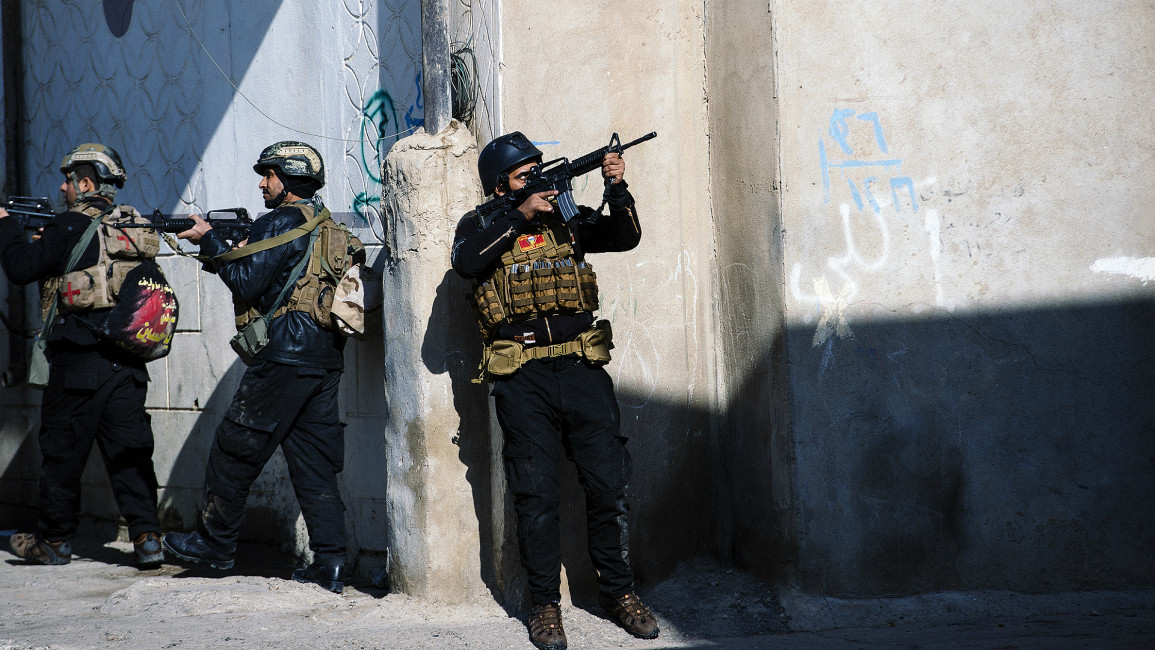Iraqi military recapture 'whole' of eastern Mosul
Iraq's military has said government troops are now in "full control" of the entire eastern side of Mosul after routing Islamic State group [IS] militants, three months after an offensive was launched against the extremist bastion.
Staff General Talib al-Sheghati told reporters on Wednesday that the left bank of the Tigris River that divides the city had been "liberated".
Sheghati said the success of the Iraqi forces was "unprecedented" and that "normal life would return to liberated areas soon".
|
Key dates in battle for Mosul - October 17, 2016: Iraqi forces launch a drive to force IS out of Mosul, where the group declared an Islamic caliphate in June 2014. IS overran Mosul and swathes of other territory north and west of Baghdad in 2014, sweeping aside security forces ill-prepared to face the assault. Around 30,000 troops from army, police and counter-terrorism units are thrown into the long-awaited counter-attack with air and ground support from the US-led coalition. By the end of October, the army has recaptured the Christian village of Qaraqosh, 15 kilometres (10 miles) from Mosul. Dozens of other nearby towns are retaken within two weeks. Entering Mosul - November 1, 2016: The army says it has entered Mosul itself for the first time since June 2014. - November 3: IS chief Abu Bakr al-Baghdadi breaks a year-long silence to urge his fighters to defend Mosul to the death, and the advance of Iraqi forces begins to slow down. - November 8: Kurdish Peshmerga fighters say they have reached Bashiqa, a dozen kilometres (about eight miles) north of Mosul. - November 13: Iraq says it has recaptured Nimrud, an ancient city southeast of Mosul. - November 23: Shia-dominated paramilitary units known as Hashed al-Shaabi say they have cut IS supply lines between Mosul and Raqa, the self-declared jihadist capital 400 kilometres (250 miles) to the west in Syria. Change of tactics - December 27, 2016: Prime Minister Haider al-Abadi says Iraqi forces need another three months to eliminate IS fighters putting up stiff resistance with car bombs, mortar attacks and sniper fire. - December 29: Government troops end a two-week pause by launching the second phase of their offensive with a change of military tactics. Tigris beachhead - January 8, 2017: Iraqi units reach the Tigris River that divides Mosul and take up positions near one of the city's five bridges, which have been knocked out one by one in air strikes. - January 14: CTS units take control of the sprawling campus of Mosul University. The United Nations puts the number of displaced persons at over 125,000 since the offensive began, of which some 14,000 have been able to move back into their homes. The number of estimated military casualties has yet to be released. Halfway there - January 18: General al-Sheghati announces "the liberation... of the left bank" of the Tigris River, two days after Iraqi forces reach the iconic Nabi Yunus shrine, also known as "Jonah's tomb" and which IS destroyed in 2014. |
The head of the counter-terrorism service, however, added that while the east of the city could be considered under government control, some work remained to be done to flush out the last holdout militants.
The "important lines and important areas are finished," he said, adding that "there is only a bit of the northern [front] remaining."
Wednesday's announcement marks the end of a phase in the operation launched on October 17 to retake Mosul, Iraq's second city and the last major urban stronghold IS has in the country.
The offensive, Iraq's largest military operation in years with tens of thousands of fighters involved, began with a focus on sparsely populated areas around Mosul.
|
An officer in the Nineveh Operations Command told The New Arab on Tuesday that he thought it would take a week before counter-terrorism forces captured the whole of the eastern side of the city.
"We have been making advances and have not been impeded by IS' defences given the air cover provided by coalition warplanes," the officer, who spoke on the condition of anonymity, said.
The west bank of Mosul is a bit smaller but is home to the narrow streets of the Old City, which are impassable to most military vehicles, and to some of the city's most loyal extremist neighbourhoods.


![President Pezeshkian has denounced Israel's attacks on Lebanon [Getty]](/sites/default/files/styles/image_684x385/public/2173482924.jpeg?h=a5f2f23a&itok=q3evVtko)





